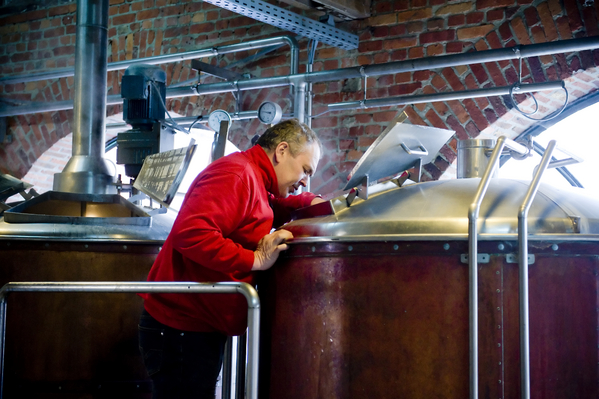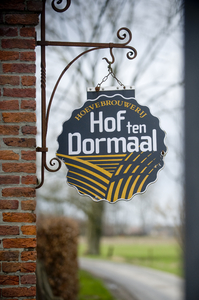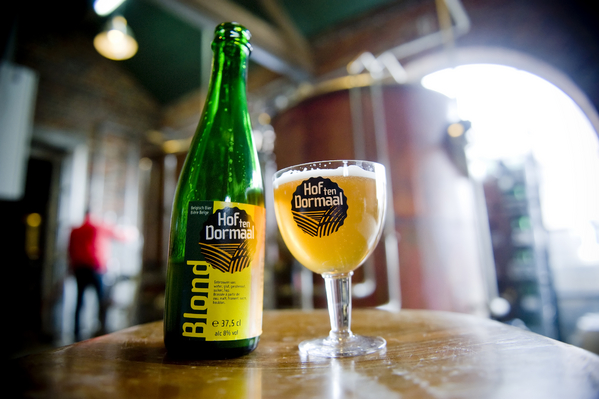Flanders Beer Trail 1: chicory and whisky add flavour to farmhouse beer in Brabant
Added: Friday, June 28th 2013

André Janssens sits in the parlour of his home, eases the champagne cork from a bottle, carefully pours beer in to a glass and passes it across the table. “I don’t brew saison,” he says firmly. “I make farmhouse beer.”
The beer is 8.5 per cent alcohol. It’s bottle fermented and has a hazy gold colour. I’m in Belgium, I’m on a farm and, if asked, I would say I was drinking saison. But I’m in the Dutch-speaking part of the country and cultural and linguistic differences are important. Saison is a style closely identified with French-speaking Wallonia, so I go with the flow and enjoy André’s farmhouse beer.
The brewery in Tildonk is called Hof ten Dormaal in flat, windswept countryside a half-hour drive from the university city of Leuven. It’s a working farm and André and his two sons raise sheep and horses, and grow their own barley and hops for brewing. They also nurture and harvest chicory, known as “white gold” as a result of its vital role in the local farming community.
André started to brew four years ago and he claims he’s the only working farmer in the whole of Belgium who grows his own malting barley and hops. An orchard close to the farmhouse has the familiar chunky poles and trellises of a hop field where the Magnum variety is clambering skywards, seeking sunshine and rain, in preparation for the autumn harvest. A spring on the farm supplies water for brewing: everything needed to make beer is on tap.
André (pictured above) leads the way from his house to a large barn where his brewing kit is housed. It has made the considerable journey from Bute, Montana, in the United States, and it neatly suits the Belgian farmhouse method of brewing, with the mash tun doubling as the boiling kettle. When the mash of malt and water has been made, with starch converted to fermentable sugar, the extract or wort is filtered to remove liquid from spent grain in a seond vessel, then returned to the mash tun for the boil with hops.
The brewhouse can make 1,500 litres at a time. Hopped wort is cooled and pumped to seven small fermenting vessels in an adjoining room of the barn. The Janssens have new fermenters on order as they need to double production to keep up with the demand for their beers.
The main beer at Hof ten Dormaal is Blond, 8%, brewed with just pale malt and Magnum hops. It has a big spicy/herbal hop aroma, with creamy malt, tart fruit and spicy hop resins on the palate, followed by a bittersweet finish rich in herbal hops, tart fruit and cookie-like malt.
A darker, 7.5% beer, Donker, is made with caramalt blended with pale. It has a ruby colour and spicy hops are balanced by burnt raisin fruit on the aroma. There are hints of coffee and chocolate in the mouth, with roasted grain and gentle hop bitterness, followed by a dry, lingering finish with delicious hints of chocolate and raisin fruit.
Wit Goud is Blond made with the addition of chicory roots. It’s called witloofbier, witloof being the Dutch name for the plant. The roots are added 30 minutes before the end of the boil with hops. The bronze-coloured beer has a herbal, spicy, vinous aroma and palate, with bitterness coming from the chicory as well as the hops.
The three farmhouse beers are the bread-and-butter brews at Hof ten Dormaal, but the Janssens have more beers up their collective sleeve. The brewhouse has several stacks of oak casks and they are used to meet André’s passion for ageing beer in barrels that originally held either spirit or wine.
I sampled Brew No 7 aged in casks obtained from the Bruichladdich distillery on the island of Islay in Scotland, famous for its peaty single malt whiskies. The beer is 12% and is lightly hopped to allow the whisky notes trapped in the wood to come through in the finished beer. The beer ages in the casks for six months and it has a peaty, oaky, smoky aroma and palate, with an iodine-like note from the whisky, followed by a bittersweet finish.
Brew No 8 is aged in casks obtained from the same distillery and were used to make the less intensely peaty Port Charlotte. The Janssens also have casks that have held Cognac, Armagnac, Madeira, port and sherry. They have an American distributor and the bulk of the oak-aged beers are sold in the U.S. The barn is too small to hold all the oak casks and the bulk of them are kept in the cellar of a monastery in Tildonk. I trust the monks are not tempted to sample the contents.
To prove this is a working farm, Dries Janssen bids me farewell in the brewhouse as he has to round up the sheep for the night with the aid of a dog called Pils. At Hof ten Dormaal, even the farm dog has a beery connection.
*Hof ten Dormaal, 2 Caubergstraat, 3150 Tildonk, Haacht. www.hoftendormaal.com. There are brewery visits on Saturdays.
Photos by Joris Bulckens, courtesy of Tourism Flemish Brabant/Toerisme Vlaams-Brabant. www.visitflanders.co.uk










